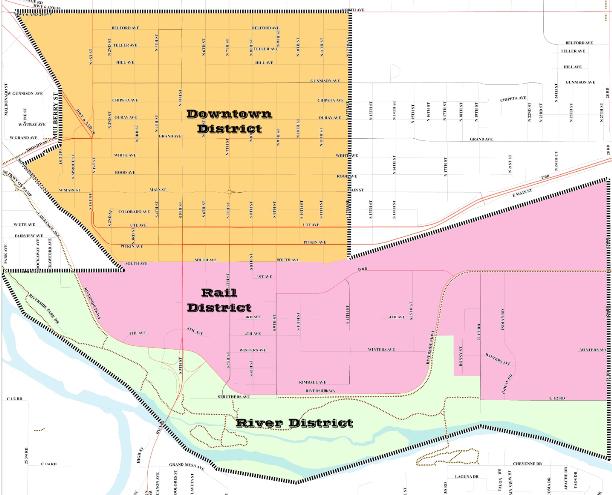Chapter 36.04
GENERAL PROVISIONS
Sections:
36.04.020 Planning background.
36.04.010 Study area context.
The Greater Downtown planning area is comprised of three subdistricts: the Downtown, Rail and River Districts. The areas are distinctly different due to their location, influences and historic development but complement each other to form a developed area that is central to the community with uses that range from single-family residential to rail-oriented heavy industrial.

(Ord. 4571, 3-20-13)
36.04.020 Planning background.
(a) A Strategic Downtown Master Plan (SDMP) that encompassed the original square mile was developed through the Downtown Development Authority (DDA) and the guidance of a steering committee of interested downtown merchants, property owners and policymakers during 2007-2008. The SDMP defined an overall vision and goals for downtown and included implementation strategies such as a zoning overlay.
The vision of the SDMP addressed the transportation network and other infrastructure, introduction of green treatments, creation of design standards and strategies for community marketing and promotion efforts. The goals of the SDMP were to:
(1) Maintain and enhance the economic, cultural and social vitality of downtown;
(2) Promote downtown living by providing a wide range of housing opportunities;
(3) Enhance the transportation system to accommodate automobiles, bikes and pedestrians, and provide adequate, convenient parking;
(4) Stabilize and enhance the historic residential neighborhoods;
(5) Establish and promote a unique identity;
(6) Jump-start the revitalization and reinvestment in the downtown area with strategic catalyst projects.
The Strategic Downtown Master Plan was considered by City Council on September 14, 2009, but, due to pending adoption of the Grand Junction Comprehensive Plan (Comprehensive Plan), Council voted to continue the SDMP to an unspecified future date.
(b) A South Downtown Neighborhood Plan (South Downtown Plan) encompassed the area between the railroad tracks and the Colorado River and the Riverside neighborhood on the west to 28 Road on the east. A plan for the area was developed from 2006-2008 with 15 community focus group meetings, three public open houses with 80 to 100 people in attendance at each open house. The South Downtown Plan included an existing conditions analysis, goals and implementation including a circulation and trails plan, economic development strategies, rezoning some properties and zoning overlay. The goals of the South Downtown Plan were to:
(1) Create, maintain and enhance a green waterfront;
(2) Recognize existing heavy industry and rail service that supports it;
(3) Recognize the distinction between “industrial” streets and “public” streets;
(4) Promote higher quality, “cleaner” uses in the area generally between 7th and 9th Streets;
(5) Improve entry points and connections to downtown;
(6) Increase light industrial opportunities;
(7) Create areas of mixed uses to screen and transition to the heavy industry;
(8) Create and enhance redevelopment opportunities and partnerships.
The South Downtown Neighborhood Plan was considered by City Council on June 16, 2008, but was not adopted.
(c) The planning process for the Greater Downtown Plan reanalyzed the two previous planning efforts and made revisions as conditions have changed, included areas that had not been covered by either of those plans, and integrated them into a single plan for the downtown area. In addition, the Greater Downtown Plan incorporates elements of the Downtown Development Authority’s potential projects in order to support the DDA’s Downtown Plan of Development, as well as incorporating elements of the Comprehensive Plan discussed below.
(Ord. 4571, 3-20-13)
36.04.030 Comprehensive Plan.
(a) The Grand Junction Comprehensive Plan is based on extensive public input that identifies what kind of community we want to have and identifies ways to achieve our vision. It charts the course to help us become the most livable community west of the Rockies. It establishes a vision that focuses the community on what it should do to sustain the quality of life that all residents desire and expect. The Comprehensive Plan establishes the following guiding principles that will shape growth, all of which apply to development of the Greater Downtown area:
(1) Concentrated Centers. The plan calls for three types of centers: the City Center, Village Centers and Neighborhood Centers.
(2) Sustainable Growth Patterns. Fiscal sustainability where we grow efficiently and cost-effectively. Encourage infill and redevelopment.
(3) Housing Variety. Allow, encourage more variety in housing types that will better meet the needs of our diverse population.
(4) A Grand Green System of Connected Recreational Opportunities. Take advantage of and tie together the exceptional open space assets of Grand Junction, including the Colorado River, our excellent park system, trails and our surrounding open spaces.
(5) Balanced Transportation. Accommodate all modes of transportation including air, transit, freight, auto, bike and pedestrian.
(6) A Regional Center. Preserve Grand Junction as a provider of diverse goods and services and residential neighborhoods.
(b) Specific policies within the Comprehensive Plan further support the concepts of the Greater Downtown Plan as outlined below.
(1) Goal 4. Support the continued development of the downtown area of the City Center into a vibrant and growing area with jobs, housing and tourist attractions.
(2) Goal 5. To provide a broader mix of housing types in the community to meet the needs of a variety of incomes, family types and life stages.
(3) Goal 6. Land use decision will encourage preservation of historic buildings and their appropriate reuse. For purposes of the Greater Downtown Plan and overlay district, a historic building is defined as one that would be eligible for inclusion on the City Register of Historic Sites, Structures and Districts according to criteria outlined in the Zoning and Development Code.
(4) Goal 8. Create attractive public spaces and enhance the visual appeal of the community through quality development.
(5) Goal 9. Develop a well-balanced transportation system that supports automobile, local transit, pedestrian, bicycle, air and freight movement while protecting air, water and natural resources.
(Ord. 4571, 3-20-13)


